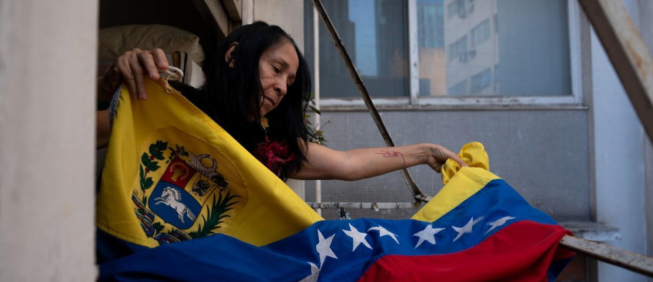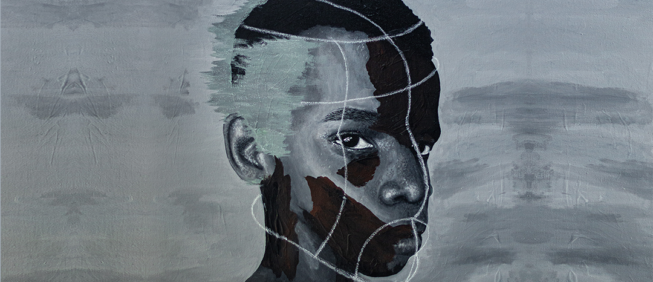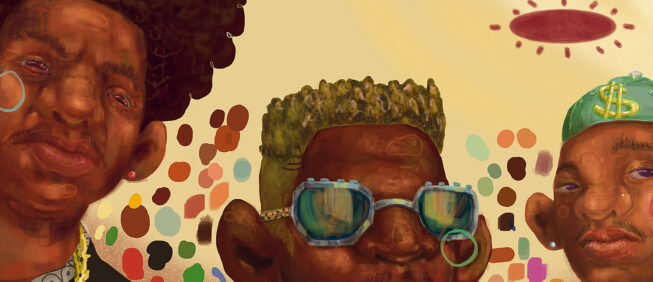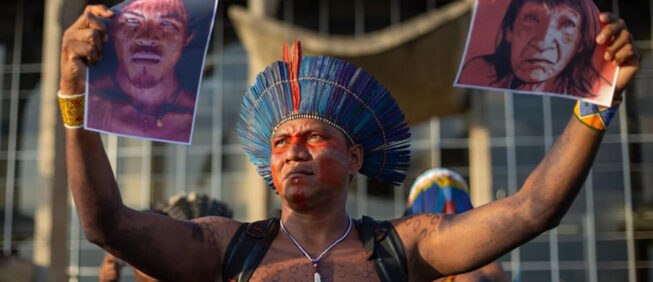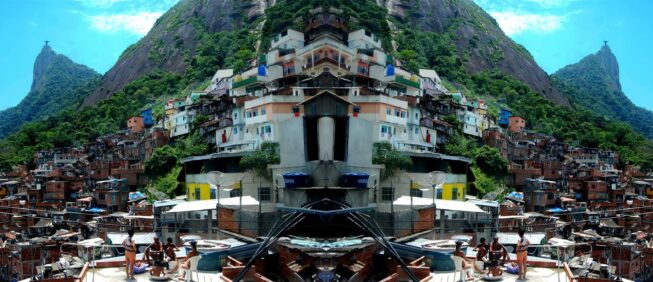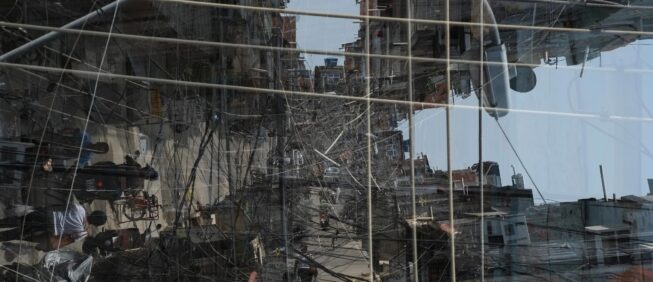On the turn of the energy of the common: the potency of the periphery and the road to the radicalization of democracy
Eduardo Alves
| Brazil |
10 de December de 2018
translated by Edmund Ruge
From the COMMON to Politics
We have chosen to open this edition of PERIPHERIES with the conceptualization of the COMMON. In Commonwealth1Hardt, Michael. Negri, Antonio. Commonwealth. Harvard University Press, 2011. , authors Michael Hardt and Antonio Negri offer the following explanation.
“first of all, [there is] the common wealth of the material world—the air, the water, the fruits of the soil, and all nature's bounty—which in classic European political texts is often claimed to be the inheritance of humanity as a whole, to be shared together. We consider the common also and more significantly those results of social production that are necessary for social interaction and further production, such as knowledges, languages, codes, information, affects, and so forth. This notion of the common does not position humanity separate from nature, as either its exploiter or its custodian, but focuses rather on the practices of interaction, care, and cohabitation in a common world, promoting the beneficial and limiting the detrimental forms of the common.”
With this, the COMMON is presented as all of nature along with the human work that transforms it, just as it constructs all relationships between men and women in the process of life’s social production. As such, human persons make themselves into social and political beings, or Zoon Politikon,2Man as political animal, or what he becomes through relations with other men a child of the aristotelian tradition. What is important here is to call attention to the societal relations between people in creative acts directed towards the transformation of nature. These relations between people in search of satisfaction for their material and spiritual needs reflect, ultimately, a search for complete human realization. This is what turns the common in our deepest human desires.
Nature and all human relation involved in its transformation on the path to broader life -- that which molds the transformation of things, and even the transformation of people themselves -- form this grand COMMON, indicating paths to fruition in common spaces of relations and positive life changes in society. These are unified actions that serve to rescue the process of appropriation, production, and sociocultural interaction that, historically, make people turn. That is, people turn within the common, in nature, in relations with other people. It is the movement of relations between people and of the transformation of nature that makes the common a fundamental part of life.
It is thus that, in this process, various questions present themselves: the first in respect to social formation and to those that constitute themselves through relations with other human beings, in a deeper process of work production and in the sociocultural identity to be constructed. The second question concerns the process of knowledge, the necessary and deep recuperation of what has been accumulated to understand, organize, deny and overcome through collective processes and cooperation. This second aspect bears great relevance to the pedagogy of coexistence, building sensibilities and common forms of knowledge to broaden life, resulting in deep coexistence among all existing pluri-diversities.
Another aspect of the COMMON also holds great relevance for our reflection. The historical appropriation of nature by the few and by political organizations, which serves to maintain and deepen the control of said organizations, presents fundamental challenges for the advancement of other social relations. Also central to our reflection is the question of how nature is appropriated, modified, and organized, both from the point of work and from a political standpoint. The appropriation of nature, with people as a part of it, is not a movement for naturalization and much less one of depletion. It is a broadening of human creative potency in all its aspects and dimensions.
This, in turn, also indicates political paths to be followed, constructed, and conquered. The public, the State, and the private sector, often called the market (though this element often combines with the State, as we will see below), directly influence the life of the polis. This presents an obstacle for the conquest and construction of a city of rights. In this sense, it is relevant to present here what Pierre Dardot and Christian Laval wrote in their book Common: On Revolution in the 21st Century:
“[...] it was the State that, in Brazil, turned over public transportation in large cities to the private sector; it is also the State that, in Istanbul, privatizes urban spaces to benefit large real-estate companies; and it is the State that, in Ethiopia, concedes to multinational corporations the lands of which it is sole proprietor with ninety-nine year contracts. The regime of private property was shaken in the 19th century by large socialists protests, such was its difficulty in justifying the appropriation of the fruits of labor of the working class.”3Translators rendering, Dardot, Pierre. Comum: Ensaio sobre a Revolução no século XXI. Boitempo Editorial 2017 [
It is therefore of great relevance to construct the important differentiation between the public and the State, keeping in mind that the act of “turn[ing] over to the private sector” is not what makes the State into a private environment. Such a process occurs at the hands of the group that holds the power of the COMMON and that organizes for its own ends through the State. This demonstrates the private character of the State. It is in this sense -- and not only in the processes of privatization -- that we can understand the particular and private character (not public!) of the State. As such, the State also becomes privatized in the extent to which it not only attends hegemonically to the interests of the financial sector -- industries and financial oligarchies -- but also to the interests of political oligarchies that possess control of and the hegemonic power of the State.
The State has historically and socially occupied the central role in the gigantic juridical-political superstructure, assuming, with conflicts and contradictions at its interior, the hegemonic task of organizing the interests of domination, of concentration and centralization of wealth socially produced for the interests of the dominant financial oligarchies. This makes the State privatized, both by way of its content and its socio-historical function. Therefore, State is not a synonym for public, that is to say, what is of the State is not necessarily public. This means to say that state policies are not necessarily public policies, although, from a juridical and ideological point of view, they are considered to be. This is also why processes of privatization, while denounced by the aforementioned authors, in the extent to which they transform state property into private property, juridically consolidate -- and therefore phenomenally -- content that, economically and politically, is already deemed non-public, given that it is something of the State, as defined here. It is exactly because of this that state affairs can not be seen conceptually and socially as public affairs, just as the juridical-political-ideological forms of organization of things and of political life can not be known only by their phenomenal aspect. They are, in turn -- and not by mere context or diversion -- their very opposite.
This is a journey toward the radicalization of democracy that demands that we construct, within the existing and known State, public interstices from civil society organizations. Such collective sets possess the necessary characteristics for critical and transformative actuation. For this to occur, however, they must unify existing pluri-diversity, broadening the potency of the peripheries through the pedagogy of coexistence: unifying the people that form this grand territory and constructing interstices, progressing towards the radicalization of democracy with conviction. We must emphasize the importance of training and organizing historically accumulated knowledge in this movement. Only through critical, qualified, and collective studies, can such a movement advance towards the broadening and overcoming of such accumulated knowledge. We must also address the challenge of deepening knowledge to transform, in collective training and mobilization, measures that enable revolutionary actions for the 21st century.
The second reflection has to do with the polis itself: that is, with the mode in which relations between people come about. This concerns people from different sectors of society - organized or not! -- and their participation in political life. More precisely, this refers to a reflection on how the participation of individuals (and organizations, in the case of civil society) in the life of the polis comes about. In other words, this lies in the formal and real organization of decision-making processes for the paths of common life in society. In this sense, state policy will only be public when these subjects of civil society -- the collectives, organizations, associations etc -- are, in fact, the subjects that are involved with such a process, something that must be addressed by the civil society organizations themselves. For these public interstices in the State to be conquered, the sectors of civil society that find themselves in contradiction to or antagonistic to the oligarchies must rise to the challenge of taking them on. Such a process creates contradictions in the State that then require construction and a broadening of the organizations that produce inputs for the process of training and mobilizing people. This process provides for personal transformation, increasingly producing collective subjects with the capacity and strength to undertake such actions. This is a process that, at the same time that it turns this huge ball of political yarn, also activates policy to shift access toward these same subjects, giving them control of and utilization of the common. This ultimately serves to meet the material and spiritual needs of the people rather than just the oligarchies. As Hardt and Negri affirm: the COMMON is dynamic. It is not only Nature that we must share, but also the knowledge that we create, the social practices that we establish, and the modes of sociability that define our human relationships.
And, in this sense, it is necessary to revisit Aristotle’s concept of the polis. For Aristotle, the polis was not necessarily the city. It was rather the construction of a community of meaning, of belonging even in its differences, but with the virtue of construction of the common. Thus, the meaning of the common comes from the construction of communities of meaning that dispute the hegemony of individualist human existence imposed by capitalism. Therefore the polis and the city are not synonyms. The polis is the community of meaning that originates in collective speech and action. And its space/time, removed from realization, emerges from subjects that live together and desire to live together. The polis is a sociopolitical journey of relationships that subjects traverse among themselves, and that only exist when some present themselves to others through action and word. In this way subjects build the recognition of human plurality, with all of its different parts. The polis is a radical democratic project, and a radical project of the common as a space for accomplishing the permanent affirmation of difference.
Civil society and the potency of the periphery
In the organizational space of civil society, with all of its conflicts, differences, and pluri-diversity of aesthetics, lies the challenge of the pedagogy of coexistence. Here we speak of the challenge of coexisting in diversity for the construction of unity. This does not mean eliminating differences, but rather consolidating the existence of diversity as a vision for the political project of the polis, meeting the full needs of these subjects in their deep diversity. Along this path of making civil society a central subject of the polis, of broadening the pedagogy of coexistence and its united diversity, the polis will be able to overcome, on one end, the aesthetics of war, and on the other, transform that which is of the State into that of the Public. The radicalization of democracy consists, thus, in the process of transforming State-Private affairs into Public affairs, making organized civil society central to the project, alongside the already pulsating centrality of the potency of the subjects of the periphery. In other words, radicalizing democracy is a process in which organized civil society subjects become central subjects of the polis, subjects that will decide, with full and unrestricted participation, the paths for common life in society. Radicalizing democracy means placing the people and civil society as central subjects of political life, and no longer as objects. Only in this way can State-Privatized affairs become, on an ever increasing scale, Public affairs. And in this process, the privatized COMMON tends to become, also increasingly, public, directly contributing to the overcoming of social inequalities. In this way, the fundamental objective of the radicalization of democracy as a form of the organization of the polis is the ever broader overcoming of social inequalities, in all their diversity and structural-institutional differences. Radicalizing democracy consists of the overcoming of inequalities on all scales in order to elevate the human condition and validate creative human potential. We can therefore say that, in this organizational process, the pedagogy of coexistence presents itself as a fundamental element. Thus, the formative action of the people in the collective process of individuation permits us to connect the diverse strings that make up this great ball of yarn that is life.
The conquest of the republic -- an essential wire in connecting all the diverse points that comprise the radicalization of democracy -- necessarily translates into the transformation of the common into increasingly collective properties of appropriation and organization, and the transformation of people into potent subjects in this process. Marx, in The Civil War in France, clearly presents the force that drives the various links of social education in the development of the republic through which democracy radicalizes. Marx affirms that “the republic is only possible as an avowedly social republic” -- that is, when the people become subjects in the molding of such an environment and the turn of the public occurs in favor of the lives of the people, in all dimensions of freedom.
This road, with all its possibility for great change, thus forms a contemporary revolutionary process. In this process it is important that we focus on knowledge, and on the potent and collective process of continued political education, always opposing those phenomena or narratives that disregard the plurality of life, and those geared to maintaining existing power structures. It is this movement that takes on the challenge, as we do this article, of not mistaking the juridical forms that separate the private and the State for their true political and economic content, placing the public and the market on profoundly distinct and contradictory grounds.
In order to hold its ground -- and to go beyond simply disputing elections -- civil society must organize itself, with mobilization and training, unifying subjects in contradiction to this model. It is fundamental to have support points in the State, whether they be in spaces conquered through electoral processes or in other spaces determined by the distinct forms of meritocracy. But such agents, whether elected or selected on merit, that act in political spheres of the State are points of connection with those collective subjects constructed in civil society. These subjects exemplify the paradigm of potency, acting to render the common into an element for the broadening of human dignity. In this sense, all elements of “inclusion” (quotas, access spaces for the impaired, and various actions that serve to reinforce the participation of fundamental subjects) in the State or in Universities, accumulate politically with favorable content for this process. They are important for the breaking down of barriers and contribute to progress against the institutional patrimonialism so present in the formation of the Brazilian State.
It is fundamental to understand what is at stake: Nature and all that is produced or is a product of work, from the circulation of goods to knowledge production, compose a common sphere that does not materialize, in modern day society, as COMMON.
Therefore, our great challenge is that of broadening and strengthening civil society organizations, specifically those that are constituted by people in contradiction with the globally predominant societal model, in which people are objects and not subjects. The path is clear. We must invest in training and mobilization in order to conquer and affirm shared rights. The dispute of hegemony points us to the construction of the polis, which will be undertaken on the grand path to the radicalization of democracy. This is a process that unifies vast sectors in contradiction to the reigning order, with, as in the periphery, the strategic subjects of this necessary and fundamental movement for life in all of its human dimensions.
Considerations, far from the finish
Those people that possess centrality in society, with organizations that present vigorous transformative energies and constitute an immense and plural territory, are the subjects of the periphery (or peripheries, though this matters little). Milton Santos, in his book Território, territórios: Ensaios sobre o Ordenamento Territorial, published by Editora Lamparina, presented a rigorous definition of territory: “Territory is the place from which all actions, passions, powers, strengths, weaknesses spring, that is where the history of man is fully realized through the manifestations of his existence.”4Translators rendering That is, people are the centrality. Thus, we do not use the term periphery as a synonym of peripheral -- something secondary, a sometimes unnecessary complement. Upon the people that form the grand territory of the periphery falls the greatest and most brutal weight of inequality. And yet, at the same time, they manifest through their solidarity and creative actions -- either through art or through cultural creation -- human potency at its highest achievable scale in current conditions. Such people are the standard for contemporary revolution (revolution that is not a synonym for war or any other type of bellic confrontation). It is they, the people, subjects of the periphery, that collectively mold themselves in the spiralling movements of progressive individuation -- a thriving transformative subject. The pedagogy of coexistence is the road that this voluminous collective subject, wrapped in the energy of the common -- and not by the scotch tape of the State or this market -- can contribute to unify all organizations with people that live the most diverse contradictions with the appropriation of the COMMON. This demands an intense and qualified transformative process, one that favors full life in which critical knowledge and solidary action serve as inputs for modern challenges. On this path, walking the public ground is a determining element, such that the radicalization of democracy be just as much a process for the training of subjects and broadening of human creative potential as it is for the elevation of life to its fullest possible condition.
Eduardo Alves | Brazil |
Organic intellectual of the periphery and member of the IMJA team
edu@imja.org.br